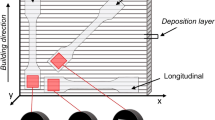For the first time, we demonstrate that the mesostructural WC–Co or WC–Ni hard alloy can be obtained as a result of ordinary liquid-phase sintering at temperatures from 1290°C to 1370°C and isothermal holding for 10–20 min. The hardness of alloys with mesostructure and a cobalt content decreasing from 28 to 20 wt.%, increases from 77.5 to 81 HRA, while the microhardness of mesoelements may increase from 4.76 to 6.3 GPa. The mesostructural WC–Co alloys are efficient in the production of mining tools for which it is necessary to guarantee high wear and impact resistance under alternating loads. At the same time, WC–Ni alloys are efficiently used in heavily loaded friction couples.




Similar content being viewed by others
References
A. F. Lisovsky, “Theory and practice of mesostructure formation in composite materials: A Review,” J. Superhard Mater., 42, No. 3, 129–144 (2020); https://doi.org/10.3103/S1063457620030065.
X. Deng, D. R. Patterson, K. K. Chawla, M. Koopman, Z. F. Zhigang, G. Lockwood, and A. Griffo, “Mechanical properties of a hybrid cemented carbide composite,” Int. J. Refractory Met. Hard Mater., 19, 547–552 (2001); https://doi.org/10.1016/S0263-4368(01)00060-9.
Z. Fang and J. A. Sue, “Double cemented carbide composites,” US Patent, N 5880382. Publ. (1999).
A. F. Lisovsky, “On the imbibition of metal melts by sintered carbides,” Powder Met. Intern., No. 5, 18–21 (1987).
A. F. Lisovsky, “The migration of metal melts in sintered composite materials,” Int. J. Refract. Hard Metals, 33, No. 8, 1599–1603 (1990).
V. P. Bondarenko, I. O. Hnatenko, O. O. Matviychuk, M. M. Prokopiv, and V. G. Zavolokin, “Study of the relationship between the cross-sectional shape of high-temperature WC grains and their microhardness,” in: Porodorazr. Metalloobr. Instr. Tekh. Tekhnol. Izgot. Primen., Issue 20 (2017), pp. 415–421; http://dspace.nbuv.gov.ua/handle/123456789/135048.
I. O. Hnatenko, Improvement of the Method for the Evaluation of the State of Carbide Skeleton of Tungsten Hard Alloys and Determination of the Influence of Technological Factors [in Ukrainian], Candidate-Degree Thesis (Engineering), Kyiv (2017).
G. S. Kreimer, Strength of Solids [in Russian], Metallurgy, Moscow (1971).
Y. V. Milman, “The effect of structural state and temperature on the mechanical properties and deformation mechanisms of WC–Co hard alloy,” J. Superhard Mater., 36, 65–81 (2014); https://doi.org/10.3103/S1063457614020014.
V. P. Bondarenko, Triboengineering Composites with High Modulus Fillers [in Ukrainian], Naukova Dumka, Kyiv (1987).
A. V. Shatov, S. S. Ponomarev, S. A. Firstov, and R. Warren, “The contiguity of carbide crystals of different shapes in cemented carbides,” Int. J. Refract. Met. Hard Mater., 24, No. 1–2, 61–74 (2006); https://doi.org/10.1016/j.ijrmhm.2005.03.003.
A. F. Lisovsky, “Role of materials science in increasing the efficiency of a rock-crushing tool equipped with WC–Co cemented carbide inserts: A Review,” J. Superhard Mater., 42, 203–222 (2020); https://doi.org/10.3103/S106345762004005X.
V. I. Pokhmurs’kyi, Kh. B. Vasyliv, V. A. Vynar, V. M. Dovhunyk, I. V. Koval’chuk, and O. P. Khlopyk, “Effect of alloying components on the tribocorrosion properties of tungsten-carbide cermets,” Mater. Sci., 51, No. 5, 869–876 (2016); https://doi.org/10.1007/s11003-016-9915-3.
V. A. Vynar, “Corrosion behavior of VN20 alloy doped with graphite or chromium and vanadium carbides,” Mater. Sci., 50, No. 5, 721–725 (2015); https://doi.org/10.1007/s11003-015-9777-0.
M. I. Dvornik and E. A. Mykhailenko, “Strength testing of VK8 hard alloy by the finite-element method,” Chem. Phys. Mesoscopy, 11, No. 4, 433–440 (2009).
A. M. Baranovskii and A. G. Bezruchko, “Antifriction materials based on the VN-type hard alloy and the experience of their application in heavily loaded couples of sliding friction,” Instrument. World, No. 1 (57), 12–15 (2013).
Author information
Authors and Affiliations
Corresponding author
Additional information
Translated from Fizyko-Khimichna Mekhanika Materialiv, Vol. 58, No. 2, pp. 29–32, March–April, 2022.
Rights and permissions
Springer Nature or its licensor (e.g. a society or other partner) holds exclusive rights to this article under a publishing agreement with the author(s) or other rightsholder(s); author self-archiving of the accepted manuscript version of this article is solely governed by the terms of such publishing agreement and applicable law.
About this article
Cite this article
Matviichuk, О.О., Andreiev, І.V., Hnatenko, І.О. et al. Technology of Formation of Mesostructures in Sintered WC–Co and WC–Ni Solid Alloys. Mater Sci 58, 175–179 (2022). https://doi.org/10.1007/s11003-022-00646-2
Received:
Published:
Issue Date:
DOI: https://doi.org/10.1007/s11003-022-00646-2




